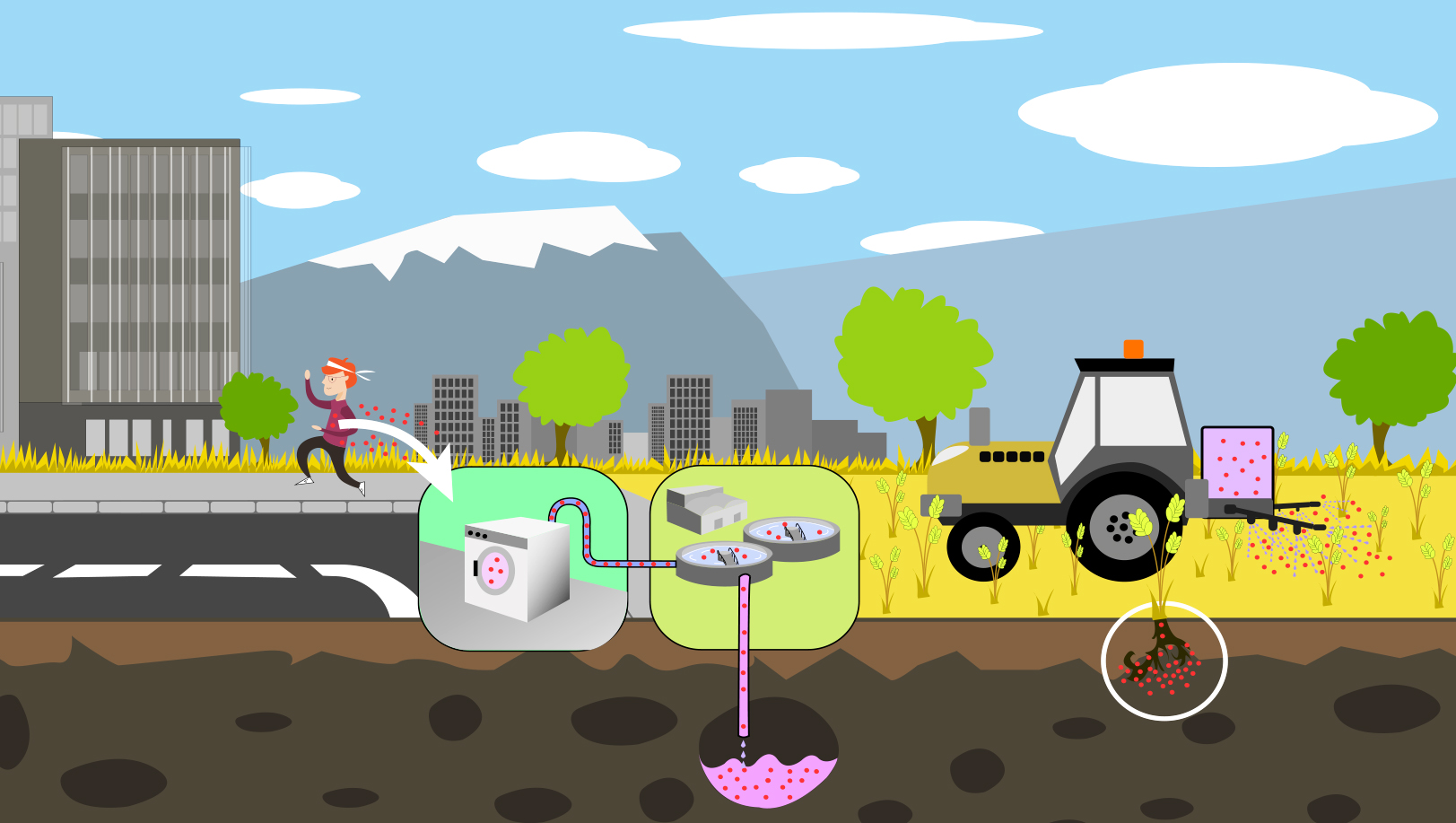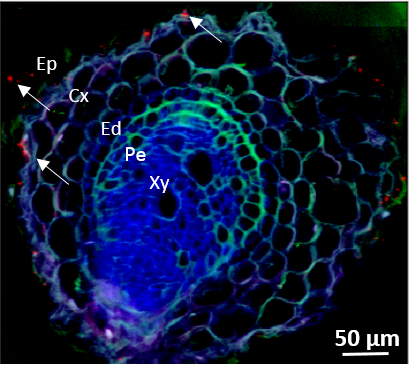- Home
- News
- General News
- #worldenvironmentday...
#worldenvironmentday Measuring the impact of nanoparticles in the environment
05-06-2017
Today it is World Environment Day. Throughout the last 20 years, researchers have been coming to the ESRF to actively study different key materials to address the new environmental challenges. In this article, we focus on the critical research on the newly-used nanoparticles in consumer products and their impact on soils and plants.
Nanoparticles are used in everyday products and their life cycle ends up in the land, where plants uptake the nanoparticles in their systems. What do we know about this process? Can this have an effect on the ecosystem balance? Can we quantify the amount of nanoparticles our bodies end up taking? Is this dangerous? Researchers at the ESRF are looking into all these questions.
Nanoparticles are being increasingly used in our everyday life, with more than 1800 registered consumer products in the market (non-comprehensive list): from silver nanoparticles in sports clothes, laundry detergents or in antibacterial products to titanium dioxide nanoparticles used in deodorants and sunscreens.
We still don’t know a lot about what happens to these particles once they enter the environment. Take a regular scenario of a runner: after going for a jog, the clothes get washed in the washing machine and the silver particles released go in the drains, which eventually will take them to surface waters and then to the soil or to Waste Waters treatment Plants. In this plants nanoparticles will be retained in sewage sludge, which is then applied as fertilizer in agricultural soils. Equally, today nanoparticles are used in pesticides. So when plants will grow on the soil what happens then? Do they get in the food chain? “It is still early days, so we can say that the effect on plants and even fruits is still quite low, but the more these nanoparticles are used in our everyday life, the bigger the concentrations will be and the bigger the effect, and that is why we are studying them already now”, says Hiram Castillo-Michel, scientist at the ESRF specialised in tracking nanotoxicity in plants.
 |
|
The cycle of silver nanoparticles: From consumer products like sports gear to the water from the washing machines, to the Water Treatment plants to sludge used in crops. Credits: C. Navarette/ ESRF. |
There are many nanoparticles being used and each of them has different properties whether they are new or they have been around for a while. The research Castillo-Michel and other scientists are leading at the ESRF consists of analysing these nanoparticles in the new and aged form and try to figure out how they interact with the macro and microorganisms in soil.
The challenge of studying nanoparticles lies in the fact that scientists need to consider the chemical (composition, mass and number concentration) and physical information (such as size, shape, aggregation), as well as the transformations the nanoparticles go through with ageing and interacting with the environment. There are not so many techniques that can do that routinely. However, using the technique of X-ray microspectroscopy on beamline ID21, researchers can study the specificity of each element present in soils and plants with a high sensitivity, spatial resolution and with minimum disruption of the native chemical environment (by freezing the sample, they maintain it in a close to in-vivo state and reduce radiation damage).
 |
|
Micro X-ray fluorescence tricolor maps of a wheat root cross section exposed to silver nanoparticles, showing silver (red), sulphur (blue) and clorine (green) in different areas of the root (Sf, surface; Ep, epidermis; Cx, cortex; Ed, endodermis; Pe, pericycle; and Xy, xylem). Silver forms small aggregates with a size of 1-4 micrometres adhered to the epidermis. Credit: Ana Elena Pradas. |
In the case of silver nanoparticles, when they age they change from metallic to silver sulfide. In collaboration with the University Grenoble Alpes, ISTerre, Aix-Marseille Université, CEA and the CNRS (France), the fate of silver nanoparticles in wheat crops has been recently investigated at ID21. They studied the silver distribution and speciation of the nanoparticles and how they moved inside the plants. The exposure to nanoparticles decreased plant growth and impacted the plant genes related to the oxidative stress or the defence against pathogens “It is very complex to interpret these data as we observed that on the epidermis and inside the root the silver nanoparticles would go through various chemical transformations but we did find out that the risk of transfer to the food chain decreases when nanoparticles are in their aged form” explains Ana Elena Pradas del Real, post-doctoral researcher on ID21.
Lettuce and crickets
Nanoparticles are also used in agriculture, in the form of nanofertilizers, nanopesticides and nanosensors directly applied to agricultural soils in order to enhance crop productivity, reduce cost, or control plant pathogens.
When nanoparticles are added to the soil, these change their size, shape and surface chemistry over time. These changes can alter the particle mobility and its access to the food chain.
The researchers studied the transformations of the nanoparticle copper oxide (CuO), used as fertilizer. Scientists focused not only on studying plants and soil, but also insects that eat the crops, in order to see whether the uptake of nanoparticles is significant. Lettuce was exposed to aged and new copper oxide and then this was fed to crickets.
The technique of X-ray fluorescence mapping showed that the copper nanoparticles interact strongly with the root systems of the lettuce plants in all cases. However, copper was more localised and randomly distributed with new nanoparticles, compared to the aged nanoparticles. Chemical modifications due to the aging process of the copper oxide nanoparticles in soils include the formation of Cu+1 oxides and sulphides, and ion release. A strong association between copper and calcium at the root epidermis was observed only for aged nanoparticle treatments which might block calcium plant uptake to the leaves. All this means that there could be potential impacts on the nutritional value of crop plants when exposed to nanoparticles.
So what happened when crickets were fed lettuce for two weeks? The answer is not much, apart from some increased copper levels in their tissues, and the crickets effectively eliminated most of the copper off their systems. “The results didn´t show a big uptake, so that is good news. But we are working on set scenarios where there is not a big inclusion of copper oxide nanoparticles in the soil to begin with”, explains Castillo-Michel.
All these examples are just a representation of a very thorough synchrotron research project that the ESRF is leading, in collaboration with outstanding multidisciplinary teams from Europe and America (Connecticul Agricultural Experiment Station, University of Massachusetts, University of Parma, University of Texas at El Paso, Universidad de Guanajuato, Elettra, University of California). “If we extrapolate our results to a medium-term future then nanoparticle toxicology in soils may become a problem as serious as the polluted former mining sites but with more complex mechanisms”, explains Castillo-Michel. And he adds: “But we need to take into account that nanoparticles have promising beneficial applications in many sectors including medicine and agriculture. Research done at the ESRF within the frame of Labex Serenade is helping to develop “safer by design” nanoparticles that allow us to take advantage of nanotechnology minimizing the environmental impact”.
Text by Montserrat Capellas Espuny
References
Top image: Credits: Cedric Navarette/ ESRF



